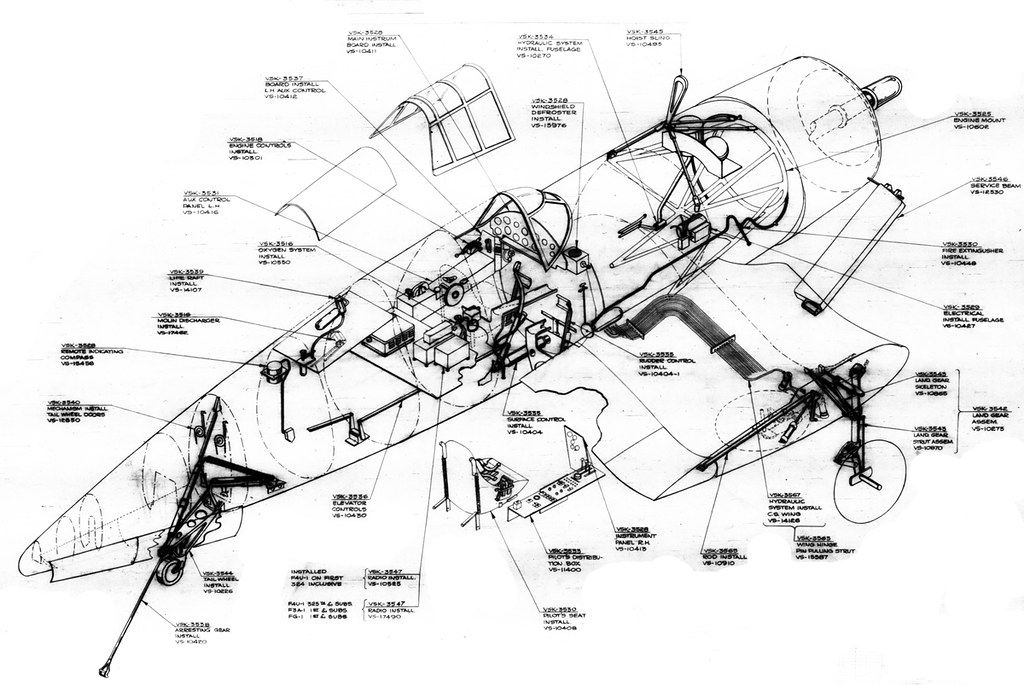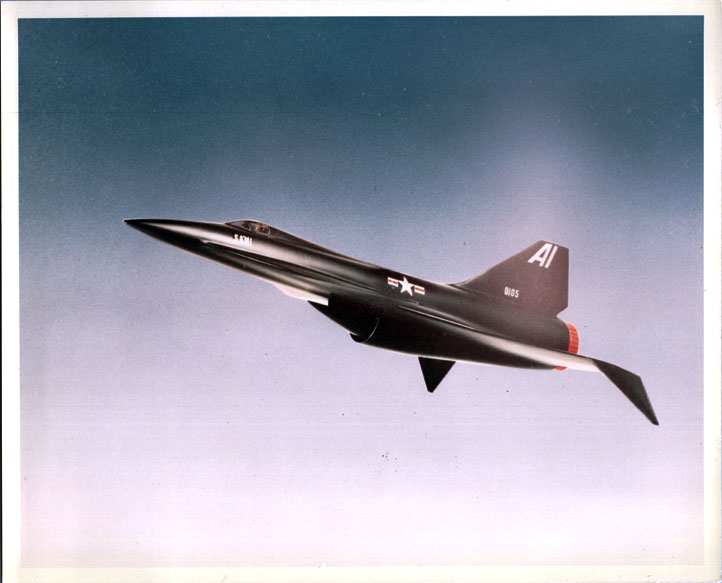Voughtworks
Friday, February 2, 2024
F4U-1 Manufacturing Views
Sunday, January 22, 2023
V-366 Landing Gear Studies
Additional design study work was requested by the BuAer for the F7U development program. The V-366A/B/C had listed "undesirable catapult take-off characteristics, unprotected fuel tanks, insufficient vision over the nose and insufficient strength to meet current Bureau strength requirements." The V-366, (improved F7U-1) with Westinghouse 24C jet engines (J46) and improved radar, armament combination.
The BuAer requested the contractor to study landing gear arrangements other than the conventional tricycle gear for application in the design. It was an attempt at solutions to the "problems associated with operating a swept wing airplane off an aircraft carrier."
The conventional tail wheel was "not satisfactory due to high bearing loads in the strut and the adverse effect on airplane balance."
Tricycle gear with addition of a small tail wheel was evaluated next. This arrangement allowed the airplane to rock back on the tail wheel as the bridle and holdback are tensioned. The catapult bridle was planned to maintain the airplane on the main and tail wheel after the catapult was fired. This study with others led to a better solution of an extensible nose wheel strut removing dependency on the catapult bridle maintaining take-off attitude.
The third arrangement was a bicycle arrangement which was more difficult to implement due to fuselage space arrangements and weight. The fuselage would need reinforcement for the landing gear loads, the out riggers had to be heavy due to barrier crash loads.
In the end it was concluded that none of the configurations considered offered improvement over the conventional tricycle landing gear of the V-366 proposal
Saturday, May 21, 2022
ADAM VTOL Tactical Transport
In February 1960, Chance Vought and Pratt and Whitney completed an Air Force study under study requirement SR-175 for a VTOL logistics and support transport that was to be operational in the 1965-70 time frame.
The proposed aircraft was to be powered by four P&W JT12A-7 engines (SR-175 ADAM VTOL Military Transport.jpg). General Dimensions: Length 53ft, Span 43ft, Height 19ft 2in. Max gross weight was targeted at 25,100lbs.
The operating cost was pitched as favorably comparable to the Lockheed Electra, Jet Star and Convair 540.
In addition to the targeted VTOL aircraft of the study a STOL version of the ADAM was included (SR-175 ADAM STOL Military Transport Swing Tail.jpg).
Wednesday, January 5, 2022
V-433 Low Cost Light Attack
In 1959 Chance Vought internal studies identified a need for a low cost, versatile light attack aircraft to serve the needs of the US Navy and Marine Corps. They created an unsolicited proposal for a turboprop attack aircraft with tricycle landing gear.
The concept was for a an aircraft optimized for close support and versatility to perform the Navy attack mission. A selling point for the aircraft would be a unit cost with Government Furnished Equipment to be under $400,000 each if the order was for 500 aircraft.
The aircraft was touted to be "all-weather" with instrument flight equipment and a ground controlled all weather bombing system. It was also mentioned that provisions would be provided for pylon mounted electronic equipment to support full all weather attack missions.The V-433 was originally to be powered by the General Electric T-64-GE-4 engine with a three bladed propeller. However, delays with that powerplant led to the selection of the Allison T-56-A-8 turning a four bladed propeller. Maximum speed at 25,000ft was projected to be .74 Mach.
The aircraft was to have six external pylons for the carriage of weapons, ECM pods, or radar pods. In addition to conventional bombs, Bullpup and Sidewinder missiles could be carried. Normal bomb load of 3,500lbs with an short range load of 4,410lbs. The V-433 could also carry 2,000lbs of special weapons instead of conventional ordinance. One of the envisioned missions was helicopter escort to support the Marine Corps and supporting a vertical envelopment for approximately 3 hours with a normal external weapons load.The V-433 was to be 35' 10" long with a wingspan of 37'.
Models by Jay Frank Dial, general arrangement courtesy of Mark N.
Saturday, September 25, 2021
Seems Like We Did This Once Before?
I recently came across a few photographs of Regulus II, XRSSM-N-9 GM2001, being loaded into C-124C 52-1067 at Hensley Field/NAS Dallas.
This was the first flight test missile (FTM). The date is February 6, 1956, the previous year the first XF8U-1 was also transported by Globemaster II also to Muroc for first flight and initial flight testing.
Being the first of class this example was powered by the Wright J65-W-6 engine. Regulus II GM2008 and subsequent were powered by the General Electric J79-GE-3A engine.GM2001 first flew on May 29, 1956 and was lost in a landing accident on August 16, 1956.
Wednesday, July 14, 2021
The Mysterious Loss of XF7U-1 122473
Previously, the short life of XF7U-1 122472 was presented in this blog along with a photo feature. This post covers the second XF7U-1 BuNo 122473 with the few details available from it's accident summary.
122473 first flew on February 15, 1949. It's brief life also included a wheels up landing just three days later on February 18, 1949. The wheels up landing resulted in repairs that grounded the aircraft until March 5, 1949 when it returned to flight status.
The aircraft started field carrier landing tests for flights 6 through 13. The short career of 122473 ended when it crashed on it's thirteenth flight.
Here are the details of 122473's final flight.
W. Millar, a CVA test pilot, took off from NAS Patuxent River, Maryland on March 14, 1949. The flight was to be a routine shakedown and the US Navy was going to take some aerial photographs of the jet. The photographic mission was accomplished and Millar broke off from the formation presumably entering the pattern to land.
The summary states: "Aircraft was never heard from again. Pilot never reported any difficulties." A widespread search of Chesapeake Bay was initiated and eventually pieces of the missing aircraft were located. The summary continues " From pieces of wreckage it was presumed that aircraft entered water gear down and slats out in a left roll."
The cause for the accident was never determined.
Sunday, November 22, 2020
Advanced Interceptor
Vought Aeronautics Division heard of interest in hypersonic interceptor aircraft in March 1968. The team went to work on an Advanced Interceptor (AI) study. Driven by Required Operational Capability (ROC) for Advanced Manned Interceptor, (LAO-3119 10 July 1968) from the USAF and a composite cycle engine evaluation study (Request for Proposal No. F33625-69-12-1453, Exhibit “A”. Statement of Work 4 October 1968) the team went to work.
VAD had already proposed a Universal Hypersonic Test Vehicle (UHTV) program earlier in the year. With a further definition of the mission for the AMI the team was able to apply their previous work on the UVHT to the new requirements.
Two of the goals for the project were to formulate aerodynamic design concepts and evaluation of candidate propulsion cycles. Five mission profiles were studies which created 13 different airplane configurations that filtered down to three refined base line configurations.
VAD viewed the mission definition of the AI as tenuous at best. The reason for that view were the different projected requirements of the USAF and SUN in purpose and complexity.
ZAP
The first mission was described as the ZAP. It consisted of the following:
1. Outbound leg of acceleration to Mach 4.5 while climbing to cruise altitude and cruise out to a range of 500 NM.
2. A 3g, power-off decelerating turn to Mach 3.0 at 80,000 ft.
3. Followed by a constant altitude, constant Mach number turn at thrust limited normal load factor not to exceed 3g
4. Engagement segment of 250 NM to inspect and attack the intercepted target.
5. Finally, a cruise and descent to sea level with a twenty minute loiter capability at Mach 0.3.
Armament
The mission profiles assumed six missiles with no specifics on missile type current or projected. For the purposes of the project six missiles totaling 2000lbs and 1000lbs for a 30 mm internal gun and ammunition filled the bill. There was one missile from a McDonnell study called the “Raytheon 400”. The missile featured a compact arrangement which made it a good candidate for internal stowage.
The ZORCH and SNAKE profiles necessitated a larger aircraft due to the range; radar needs and second crew member to operate the radar. Designs included external conformal phased radar antennas but also permitted an interplanar array of 36 in diameter.
Crew Accommodations
There was a requirement for forward visibility equivalent to current fighters, which was a challenge with the heating challenges and high angles of attack for landing which led to tilting nose arrangements. The crew also had to be provided and escape capsule due to the high speeds. A closed-circuit video display was later proposed to eliminate the complexity of the tilting nose.
Engine Types
They engine types evaluated were fascinating in name as well as function: Supercharged Ejector Ramjet (SERJ), Plenum Burning Turbofan, Turbojet, Turboramjet, Rocket Augmented Turboramjet, Airturborocket, Turbofanramjet, Supersonic Inflow Turbofanramjet, Turboramjet-Stoichiometric Core, Afterburning Turbojet and finally Combination, Rocket, Ramjet, Turbofan,
Recommendations
In the end the VAD team developed two base line aircraft designs the A-105 and the A-505. The recommendation also included a design maximum speed of Mach 4.5 due to the constraints of fuel selection and construction materials available at the time. For an engine they stated that the Supercharged Ejector Ramjet (SERJ) and the Turbofanramjet (TFRJ) were the most promising.
AI-105K
Further visuals on the AI-105K
Production break down drawing of an AI-101



























